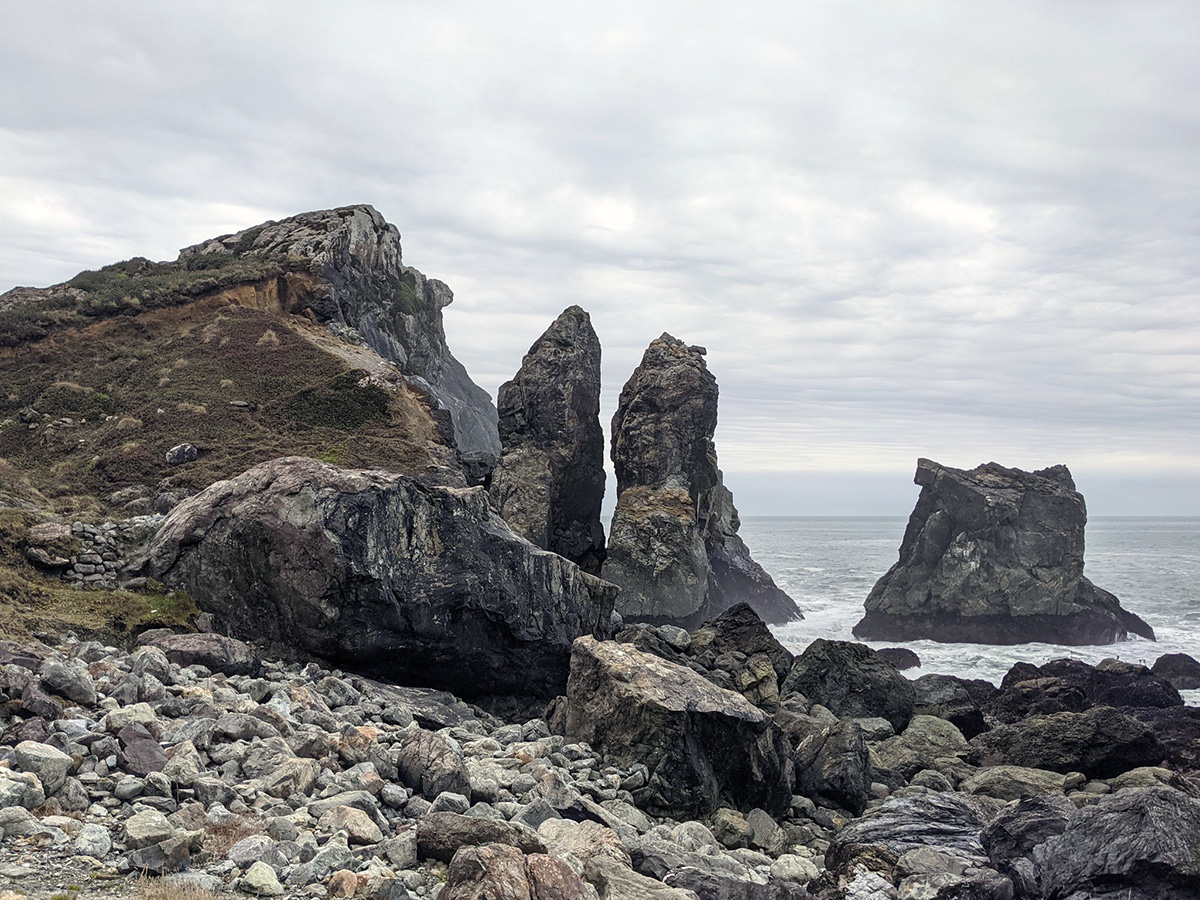1月14号的日记(昨天的),由于做完风格迁移已经很晚了,所以就没整理日记,今天早上才发。昨晚有些地方不是很懂,今天调试、跑了一遍损失函数后,理解了很多。生成式学习是有很大实际价值的一个方向,让AI进行艺术创作,也是这两年的热点。这章花了一天半时间了,还没有搞定,今天估计还得学一天。
DeepDream
DeepDream是利用了梯度上升,求得使某些层激活值最大的原始图像。步骤是输入一个原始图像,然后用梯度上升,使得某些层的激活值最大。这样的图像具有迷幻般的图案,让我们试一试。下载图片并且定义好模型:
base_image_path=tf_keras.utils.get_file('coast.jpg',origin='https://img-datasets.s3.amazonaws.com/coast.jpg')
from tensorflow.keras.applications import inception_v3
model=inception_v3.InceptionV3(include_top=False)
# model.summary()
# plot_model(model,'inception.png',dpi=200)
layer_settings={
'mixed4': 1.0,
'mixed5': 1.5,
'mixed6': 2.0,
'mixed7': 2.5,
} # 将这些层的激活值最大化,给出了每个层在总损失函数中所占的比重,调整比重可以获得不同视觉效果
outputs_dict=dict( # 每一层的符号化输出
[(layer.name,layer.output)
for layer in [model.get_layer(name) for name in layer_settings.keys()]
])
feature_extractor=keras.Model(model.inputs,outputs_dict) # 模型的返回格式为字典
其余代码:
def compute_loss(input_image):
features=feature_extractor(input_image) # 得到激活值,一个字典
loss=tf.zeros(shape=()) # 标量
for name in features.keys():
coeff=layer_settings[name] # 权重
activation=features[name] # 计算出来的激活值
loss+=coeff*tf.reduce_mean(tf.square(activation[:,2:-2,2:-2,:])) # 避免边界伪影,裁剪一下
return loss # 要使损失函数最大化,把每个值平方后取平均
@tf.function
def gradient_ascent_step(image,learning_rate):
with tf.GradientTape() as tape:
tape.watch(image) # 其加入观测
loss=compute_loss(image)
grads=tape.gradient(loss,image)
grads=tf.math.l2_normalize(grads) # 梯度规范化,变化更平缓
image+=learning_rate*grads # 梯度上升
return loss,image
def gradient_ascent_loop(image,iterations,learning_rate,max_loss=None):
for i in range(iterations) : # 每一次迭代都更新图像
loss,image=gradient_ascent_step(image,learning_rate)
if max_loss is not None and loss>max_loss: # 超过阈值就可以终止,过度循环会产生不必要的伪影
break
print(f'Loss at step {i}: {loss:.2f}')
return image
step=20. # 梯度上升的步长(学习率
num_octave=3 # 在3个尺度上运行梯度上升
octave_scale=1.4 # 连续尺度之间尺寸的比例
iterations=30 # 每个尺度上运行梯度上升的步数
max_loss=15 # 损失函数超过这个值就停止梯度上升
def preprocess_image(image_path): # 打开图像,调整尺寸,转换为适当的格式
img=tf_keras.utils.load_img(image_path) # 从磁盘加载
img=tf_keras.utils.img_to_array(img) # 变成数组
img=np.expand_dims(img,axis=0) # 批尺寸为1
img=tf_keras.applications.inception_v3.preprocess_input(img) # 图像预处理
return img
def depeocess_img(img): # 将np数组转换为有效的图像
img=img.reshape((img.shape[1],img.shape[2],3))
img/=2.0
img+=0.5
img*=255. # 对inception V3所做的预处理进行逆向操作
img=np.clip(img,0,255).astype('uint8')
return img
original_img=preprocess_image(base_image_path) # 加载原图像
print(original_img.shape)
original_shape=original_img.shape[1:3] # 丢弃批尺寸
successive_shapes=[original_shape] # 最终的图像尺寸
for i in range(1,num_octave): # 对于每一个八度
shape=tuple([int(dim/(octave_scale**i)) for dim in original_shape]) # 本个八度中图像的尺寸,下一个八度将翻1.4倍
successive_shapes.append(shape)
successive_shapes=successive_shapes[::-1] # 逆序,按尺寸从小到大排序,共有3个八度
print(successive_shapes)
shrunk_original_img=tf.image.resize(original_img,successive_shapes[0])
# 上一个八度的尺寸,第一个八度的上一个八度初始化为第一个八度。保存上一个八度的原始图像用于还原丢失的细节
img=tf.identity(original_img) # 复制图片,保留原始图像
for i,shape in enumerate(successive_shapes): # 开始处理图片,分三个八度
print(f'Processing octave {i} with shape {shape}') # 大于当前八度的图片尺寸
img=tf.image.resize(img,shape) # 调整到需要的尺寸
img=gradient_ascent_loop(img,iterations,learning_rate=step,max_loss=max_loss) # 进行当前八度的梯度上升
upscaled_shrunk_original_img=tf.image.resize(shrunk_original_img,shape) # 将当前八度的原始图像放大,得到像素化图片
same_size_original=tf.image.resize(original_img,shape) # 将原始图片缩小到当前八度的图片,得到高质量图片
lost_detal=same_size_original-upscaled_shrunk_original_img # 丢失的细节
img += lost_detal # 还原丢失的细节
shrunk_original_img=tf.image.resize(original_img,shape) # 更新上一个八度的原始图像
plt.imshow(depeocess_img(img.numpy()))
plt.show()
tf_keras.utils.save_img('dream.png',depeocess_img(img.numpy())) # 保存结果
原图片:

加了效果以后:

感觉怪瘆人的,到处都是眼睛、羽毛之类的。
风格迁移
风格迁移可以把A图片的风格迁移到B图片上,而B图片的内容不会发生改变,仅改变风格,是一种挺有趣的玩法。方法是用梯度下降法,损失函数包含3部分:生成图片和风格图片之间的风格损失函数、生成图片和内容图片之间的内容损失函数、生成图片与自身的变差损失函数(使生成的图片平滑、连贯)。风格损失函数用两张图片的gram矩阵刻画。第一个通道与第一个通道对应像素相乘,结果相加得到矩阵(1,1)位置的值。简而言之就是第i个通道和第j个通道对应像素点相乘,然后把结果相加得到矩阵(i,j)位置的值。gram矩阵刻画了不同通道之间的相互关系,这些相互关系抓住了在某个空间尺度上的模式的统计规律,即纹理外观。
把生成图片的gram矩阵和风格图片的gram矩阵相减并取平方,把所有元素求和后得到一个损失值,这个值越小,说明两者的风格越接近。
base_image_path=tf_keras.utils.get_file('sf.jpg',origin='https://img-datasets.s3.amazonaws.com/sf.jpg') # 内容图片
style_reference_image_path=tf_keras.utils.get_file('starry_night.jpg',
'https://img-datasets.s3.amazonaws.com/starry_night.jpg') # 风格图片
base_image_path='我的自拍.jpg'
style_reference_image_path='抽象画.jpg'
# print(base_image_path)
# print(style_reference_image_path)
original_width,original_height=tf_keras.utils.load_img(base_image_path).size # 内容图片宽和高
img_height=400 # 生成图片的高度
img_width=round(original_width*img_height/original_height) # 按比例获取宽度
def preprocess_image(image_path): # 打开图像,调整尺寸,转换为np数组
img=tf_keras.utils.load_img(image_path,target_size=(img_height,img_width)) # 读取图片,按生成图片的比例来
img=tf_keras.utils.img_to_array(img)
img=np.expand_dims(img,axis=0)
img=tf_keras.applications.vgg19.preprocess_input(img)
return img
def deprocess_img(img): # 将numpy数组转换为有效的图像(0~255范围)
img=img.reshape((img_height,img_width,3))
img[:,:,0]+=103.939
img[:,:,1]+=116.779
img[:,:,2]+=123.68
# 预处理的逆操作
img=img[:,:,::-1] # 将BGR转化为RGB,也是对预处理的逆操作
img=np.clip(img,0,255).astype('uint8')
return img
model=tf_keras.applications.vgg19.VGG19(include_top=False)
outputs_dict=dict([(layer.name,layer.output)for layer in model.layers])
feature_extractor=keras.Model(model.inputs,outputs_dict)
def content_loss(base_img,combination_img): # 评估内容的损失函数
return tf.reduce_sum(tf.square(combination_img-base_img)) # 拿原始图片和生成图片的最后几个层的通道进行比较
def gram_matrix(x):
x=tf.transpose(x,(2,0,1)) # x是一张特征图,转置,把通道数移到最前面
features=tf.reshape(x,(tf.shape(x)[0],-1)) # 按通道数拉平,现在每个通道都是一个很长的向量
gram=tf.matmul(features,tf.transpose(features)) # 矩阵乘法,得到格拉姆矩阵
# 第一个通道与第一个通道对应像素相乘,结果相加得到矩阵(1,1)位置的值
# 简而言之就是第i个通道和第j个通道对应像素点相乘,然后把结果相加得到矩阵(i,j)位置的值
# gram矩阵刻画了不同通道之间的相互关系,这些相互关系抓住了在某个空间尺度上的模式的统计规律,即纹理外观。
return gram
def style_loss(style_img,conination_img):
S=gram_matrix(style_img) # 风格图像的格拉姆矩阵
C=gram_matrix(conination_img) # 生成图像的格拉姆矩阵
channels=3 # 通道数
size=img_height*img_width # 总的像素数目
return tf.reduce_sum(tf.square(S-C)) / (4.0*(channels**2)*(size**2)) # 该损失函数描述两图片的风格差异
def total_variation_loss(x): # 总变差损失,使得图像具有空间连续性
a=tf.square(x[:,:img_height-1,:img_width-1,:] - x[:,1:,:img_width-1]) # 将图片向下移动一格
b=tf.square(x[:,:img_height-1,:img_width-1,:] - x[:,img_height-1,1:]) # 将图像向右移动一格
return tf.reduce_sum(tf.pow(a+b,1.25))
style_layer_names=[ # 用于风格损失
'block1_conv1',
'block2_conv1',
'block3_conv1',
'block4_conv1',
'block5_conv1',
]
content_layer_name='block5_conv2' # 用于内容损失
total_variation_weight=1e-8
style_weight=1e-6
content_weight=2.5e-9
def compute_loss(combination_image,base_image,style_reference_image):
input_tensor=tf.concat([base_image,style_reference_image,combination_image],axis=0)
# 将原图片,风格图片和目标图片组成一个批,输入模型
features=feature_extractor(input_tensor) # 返回一个字典,存储了所有层的输出
loss=tf.zeros(shape=()) # tf标量,损失函数初始为0
layer_features=features[content_layer_name] # 最后一个卷积层的特征
base_image_features=layer_features[0,:,:,:] # 取出原图片
combination_features=layer_features[2,:,:,:] # 取出目标图片
loss += content_weight*content_loss(base_image_features,combination_features) # 计算内容损失函数
for layer_name in style_layer_names: # 对于每个用来计算风格损失函数的层
layer_features=features[layer_name] # 获取该层的输出值
style_reference_features=layer_features[1,:,:,:] # 风格图片
combination_features=layer_features[2,:,:,:] # 生成图片
style_loss_value=style_loss(style_reference_features,combination_features) # 计算风格损失函数
loss += (style_weight/len(style_layer_names)) * style_loss_value # 由于有多个层用于计算,所以这里只是len()分之一
loss += total_variation_weight*total_variation_loss(combination_image) # 添加生成图像的总变差损失
return loss
# @tf.function
def compute_loss_and_grads(combination_image,base_image,style_reference_image):
with tf.GradientTape() as tape:
loss=compute_loss(combination_image,base_image,style_reference_image)
grads=tape.gradient(loss,combination_image) # 梯度下降求原图片
return loss,grads
optimizer=tf_keras.optimizers.SGD(tf_keras.optimizers.schedules.ExponentialDecay(
initial_learning_rate=100.0,decay_steps=100,decay_rate=0.96 # 初始学习率为100,然后每100步减4%
))
base_image=preprocess_image(base_image_path)
style_reference_image=preprocess_image(style_reference_image_path)
combination_image=tf.Variable(preprocess_image(base_image_path))
iterations=4000
for i in range(1,iterations+1):
loss,grads=compute_loss_and_grads(combination_image,base_image,style_reference_image)
optimizer.apply_gradients([(grads,combination_image)])
if i %100==0:
print(f'Iteration {i}: loss={loss:.2f}')
img=deprocess_img(combination_image.numpy())
fname=f'生成图像6/第{i}轮.png'
tf_keras.utils.save_img(fname,img)
























 1863
1863











 被折叠的 条评论
为什么被折叠?
被折叠的 条评论
为什么被折叠?










